
A banyan, also spelled banian, is a fig that develops accessory trunks from adjacent prop roots, allowing the tree to spread outwards indefinitely. This distinguishes banyans from other trees with a strangler habit that begin life as an epiphyte, i.e. a plant that grows on another plant, when its seed germinates in a crack or crevice of a host tree or edifice. "Banyan" often specifically denotes Ficus benghalensis, which is the national tree of India, though the name has also been generalized to denominate all figs that share a common life cycle and used systematically in taxonomy to denominate the subgenus Urostigma.

Sacred groves or sacred woods are groves of trees that have special religious importance within a particular culture. Sacred groves feature in various cultures throughout the world.
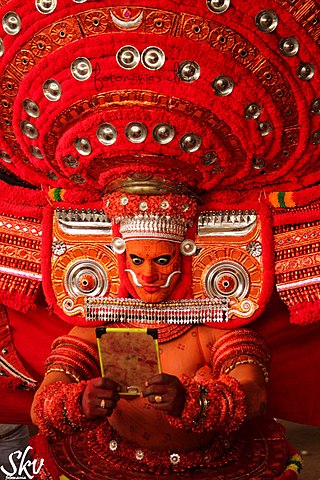
Theyyam is a Hindu religious ritual practiced in northern Kerala and some parts of Karnataka. Theyyam is also known as Kaḷiyāṭṭaṁ or Tiṟa. Theyyam consists of traditions, rituals and customs associated with temples and sacred groves of Malabar. The people of the region consider Theyyam itself as a channel to a god and they thus seek blessings from Theyyam.

The ChottanikkaraDevi Temple is a temple dedicated to the Hindu mother goddess Bhagavati Lakshmi. She is believed to be residing in Chottanikkara (Mahalakshmi) along with her Husband Maha Vishnu. The main deity is also considered as Lakshmi Narayana according to the temple legend. The temple is Classified one among the 108 Abhimana Kshethram of Vaishnavate tradition. The temple is located at Chottanikkara, a southern suburb of the city of Kochi in Ernakulam district, in the state of Kerala, India and is one of the most popular temples in the state. The temple is also known for conducting exorcism.

Muthappan is a deity commonly worshiped in the Kannur, Kasargod, Kozhikode, Malappuram region of Kerala and Coorg region of Karnataka in India. Muthappan is considered as the personification of two Hindu gods — the Thiruvappan or Valiya Muthapan (Vishnu) and the Vellatom or Cheriya Muthapan (Shiva).

Bhadrakali is a Hindu goddess. She is considered to be the auspicious and fortunate form of Adi Shakti who protects the good, known as bhadra.

The culture of Kerala has developed over the past millennia, influences from other parts of India and abroad. It is defined by its antiquity and the organic continuity sustained by the Malayali people. Modern Kerala society took shape owing to migrations from different parts of India and abroad throughout Classical Antiquity.

Madayi. is a Census Town and Grama panchayat in Kannur district of Kerala state, India.
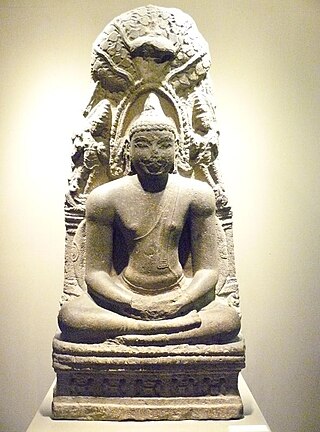
A sacred tree or holy tree is a tree which is considered to be sacred, or worthy of spiritual respect or reverence. Such trees appear throughout world history in various cultures including the ancient Hindu mythology, Greek, Celtic and Germanic mythologies. They also continue to hold profound meaning in contemporary culture in places like Japan (shinboku), Korea, India, and the Philippines, among others. Tree worship is core part of religions which include aspects of animism as core elements of their belief, which is the eco-friendly belief that trees, forests, rivers, mountains, etc have a life force and need to be conserved and used in a sustainable manner.

Sacred groves of India are forest fragments of varying sizes, which are communally protected, and which usually have a significant religious connotation for the protecting community. Hunting and logging are usually strictly prohibited within these patches. Other forms of forest usage like honey collection and deadwood collection are sometimes allowed on a sustainable basis. NGOs work with local villagers to protect such groves. Traditionally, and in some cases even today, members of the community take turns to protect the grove. The introduction of the protected area category community reserves under the Wild Life (Protection) Amendment Act, 2002 has introduced legislation for providing government protection to community held lands, which could include sacred groves.
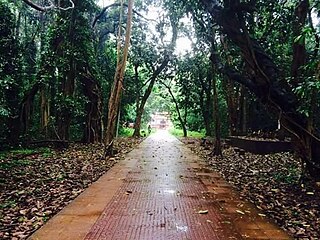
Kāvû is the traditional name given for sacred groves across the Malabar Coast in Kerala, South India. Kavus are notable for Theyyam, the centuries-old ritual dance.

Madayikavu (Māḍāyik्kavu), also known as Thiruvarkadu Bhagavathi Temple, is a significant ancient Kaula Shakti shrine in Kerala, located near Pazhayangadi, Kannur. With a distinguished history spanning over two millennia, the Kavu was administered by various regional dynasties. The Bhagavathi was revered by these dynasties as their royal family deity, and they also carried out renovations of the Kavu at multiple junctures throughout history.
Sree Chirakkakavu Bhagavathi Temple is one of the oldest Devi Temples in North Kerala.

Sree Andalurkavu is a very ancient and famous and prominent Thiyya Community Urayima temple in Andalur in Dharmadam village of Kannur district, Kerala, India. It counts among the Abhimana Kshethras of Vaishnavite Shrines. This ancient temple is in the name of Lord Rama and the main festival is celebrated in mid-February: the first week of the month "Kumbam" of the Malayalam calendar. This Kavu also has a story of how the Kalaripayat warrior Thacholi Othenan, who once caused trouble in this Thiyar-dominated Kavu Andalur of Thalassery, was punished and defeated by the Thiyars and crossed the country through the bridge.
There are places of worship considered important in the Kannur district. Kannur District is one of the 14 districts in the state of Kerala, India. The town of Kannur is the district headquarters, and gives the district its name.
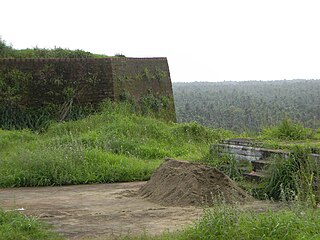
Madayipara is a flat-topped hillock located in the Madayi, of Kannur district of Kerala state in the Southern India. It overlooks the town of Payangadi on the northern bank of Kuppam River.
Manikkadave or Manikkadavu is a village in Kannur district, Kerala, India. It is situated among the foothills of Western Ghats, and bordering the Kodagu range of Karnataka evergreen forests. As its crown there lies ‘Kurisu Mala’ forest in the west beyond which it is Paadan Kavala and other tourism points of Kanjirakolly. Manikkadavu is located 15 km north of the town Iritty, and is 56 km north-east of the district capital Kannur. It is between the towns/villages of Ulikkal, Payyavoor, and Kanjirakolli. The village is situated about 538 km north of state capital Thiruvananthapuram.
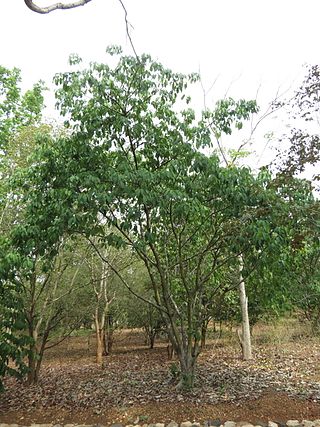
Ficus tsjahela is a fig tree from the family Moraceae which is found in peninsular India and Sri Lanka. It is commonly known as the kaaral in Malayalam, kal-aal in Tamil and boviyamara in Kannada.
The following are places of worship in Cherupuzha:

The sacred groves is a zone of Biodiversity Park, Visakhapatnam located in the premises of Rani Chandramani Devi Government Hospital. It has more than 100 sacred plant species, which are medicinal herbs with religious importance. Many sacred plants are becoming rare and endangered. Hence they are to be reared, protected, and conserved. The zone was inaugurated on February 5, 2017, by Kambhampati Hari Babu, a member of parliament from Visakhapatnam, Andhra Pradesh.
![niiliyaa[?] koottttN 23.jpg](http://upload.wikimedia.org/wikipedia/commons/thumb/b/b4/%E0%B4%A8%E0%B5%80%E0%B4%B2%E0%B4%BF%E0%B4%AF%E0%B4%BE%E0%B5%BC_%E0%B4%95%E0%B5%8B%E0%B4%9F%E0%B5%8D%E0%B4%9F%E0%B4%82_23.jpg/272px-%E0%B4%A8%E0%B5%80%E0%B4%B2%E0%B4%BF%E0%B4%AF%E0%B4%BE%E0%B5%BC_%E0%B4%95%E0%B5%8B%E0%B4%9F%E0%B5%8D%E0%B4%9F%E0%B4%82_23.jpg)















